Upgrading Community’s Dried Flower Products as Souvenirs and Decorative from Community Capital at Din Thong Sub-district, Phitsanulok Province
Main Article Content
Abstract
This research aims to develop a community’s dried flower products to be certified by Thai community product standards and to transfer knowledge and technology of dried fresh flower production to the target communities in Din Thong sub-district, Wang Thong district, Phitsanulok province. This study focuses on the implementation of community participation. Scopes for conducting the study include 1) survey of the community context, physical information, social capital, local wisdom, problems, and demand, 2) development of products to be certified by community product standards, 3) transfer of knowledge and technology through workshops and 4) marketing. Targets of this study consist of 40 people including the locals, community leaders, community development officers, and stakeholders. Data are collected through group meeting participation, observation, and interviews. Tools in this study are questionnaires and interview forms. The results shows that Din Thong community has formed and registered as a new career group. Their value added dried fresh flowers produced from local resources are certified by Thai community product standards. From the workshops, the participants reveal high levels of satisfaction in project participation and ability to learn and practice accordingly. For marketing, the products are available for sale at stores in provincial tourist attraction sites, and the social media channel as Facebook page “Sattri Sri Din Thong Group” is also open for online business. This product can generate additional revenue for the community.
Article Details

This work is licensed under a Creative Commons Attribution-NonCommercial-NoDerivatives 4.0 International License.
Area Based Development Research Journal values copyright protection and licensing to safeguard author rights and facilitate the appropriate dissemination of research. Our policies ensure openness, accessibility, and attribution. Authors retain copyright ownership, and articles are published under a Creative Commons Attribution License (CC BY), allowing sharing, adaptation, and proper attribution. Authors have the freedom to publish under the CC BY license, granting broad reuse and distribution permissions. The journal supports posting articles on third-party repositories, adhering to institutional and funding restrictions. Author guidelines detail copyright and licensing requirements, empowering authors with knowledge about their rights and responsibilities. These policies cultivate an environment of collaboration, openness, and responsible sharing, benefiting authors and the research community while honoring intellectual property rights.
References
กรมการพัฒนาชุมชน. (2561). คู่มือการขับเคลื่อนการดำเนินงาน โครงการชุมชนท่องเที่ยว OTOP นวัตวิถี. กรุงเทพฯ : กระทรวงมหาดไทย.
ตระกูลพันธ์ พัชรเมธา. (2558). การออกแบบและพัฒนาผลิตภัณฑ์จากขี้เลื่อยไม้ยางพารา. วารสารวิชาการ คณะสถาปัตยกรรมศาสตร์, 14(1), 83-94.
พาขวัญ ทองรักษ์, วรรภา วงศ์แสงธรรม, สุภาพร พาเจริญ, จันทร์เพ็ญ บุตรใส และรุ่งทิพย์ ไทยสม. (2560). การพัฒนากระบวนการผลิตข้าวเกรียบมันเทศสู่การผลิตเชิงพาณิชย์โดยชุมชนมีส่วนร่วม. วารสารวิจัยเพื่อการพัฒนาเชิงพื้นที่, 9(4), 242-256.
มนตรี สังข์ทอง. (2560). รูปแบบการประเมินภายในเพื่อขับเคลื่อนการวิจัยในพื้นที่. วารสารวิจัยเพื่อการพัฒนาเชิงพื้นที่, 9(4), 235-241.
วีระพงษ์ กิติวงศ์ และ กมลพงศ์ รัตนสงวนวงศ์. (2561). การวิจัยเชิงปฏิบัติการโดยใช้แนวคิดการประเมินชุมชนแบบมีส่วนร่วมเพื่อสร้างความเข้มแข็ง กลุ่มอาชีพสร้างเข่งปลาทูบ้านสันจกปก จังหวัดพะเยา. วารสารวิจัยเพื่อการพัฒนาเชิงพื้นที่, 10(4), 306-330.
สุภา จุฬคุปต์ และคณะ. (2552). การพัฒนาดอกบัวสดอบแห้ง (รายงานวิจัยฉบับสมบูรณ์). ปทุมธานี: มหาวิทยาลัยเทคโนโลยีราชมงคลธัญบุรี.
สำนักงานคณะกรรมการข้าราชการพลเรือน (2561). ยุทธศาสตร์ชาติ และการปฏิรูปประเทศ. สืบค้นเมื่อวันที่ 25 ตุลาคม 2561, จาก https://www.ocsc.go.th/sites/default/files/attachment/page/99049.pdf.
สำนักงานพัฒนาชุมชนจังหวัดพิษณุโลก. (2561). ข้อมูลความจำเป็นพื้นฐานระดับอำเภอ ปี 2561. สืบค้นเมื่อวันที่ 25 ตุลาคม 2561, จาก https://phitsanulok.cdd.go.th/wp-content/uploads/sites/38/2018/07/07- รายงานคุณภาพชีวิตของประชาชน จังหวัดพิษณุโลก จากข้อมูล จปฐ. ปี2561.
อรัญ วานิชกร. (2559). การออกแบบผลิตภัณฑ์ท้องถิ่น (OTOP). กรุงเทพฯ: สำนักพิมพ์แห่งจุฬาลงกรณ์มหาวิทยาลัย.
อารยา เสือเดช. (2559). กระบวนการส่งเสริมการขายสินค้าชุมชนผ่านช่องทางระบบพาณิชย์อิเล็กทรอนิกส์กรณีศึกษา : วิสาหกิจชุมชนสายบัว. (การค้นคว้าอิสระศิลปศาสตรมหาบัณฑิต). มหาวิทยาลัยธรรมศาสตร์, วิทยาลัยพัฒนศาสตร์ ป๋วย อึ๊งภากรณ์, สาขาชนบทศึกษาและการพัฒนา.
องค์การบริหารส่วนตำบลดินทอง. (2561). ข้อมูลสภาพทั่วไป ปี 2561. สืบค้นเมื่อวันที่ 25 ตุลาคม 2561, จาก https://www.dinthong.go.th/condition.php.


